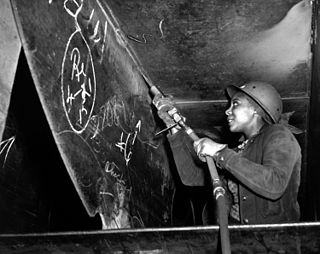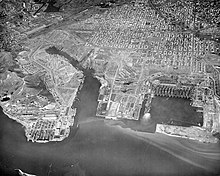
Vigor Shipyards is the current entity operating the former Todd Shipyards after its acquisition in 2011. Todd Shipyards was founded in 1916, which owned and operated shipyards on the West Coast of the United States, East Coast of the United States and the Gulf. Todd Shipyards were a major part of the Emergency Shipbuilding Program for World War II.

Rosie the Riveter World War II Home Front National Historical Park is a United States national historical park located in Richmond, California, near San Francisco. The park preserves and interprets the legacy of the United States home front during World War II, including the Kaiser Richmond Shipyards, the Victory ship SS Red Oak Victory, a tank factory, housing developments and other facilities built to support America's entry into World War II. In particular, the role of women and African-Americans in war industries is explored and honored.
SS Robert E. Peary was a Liberty ship which gained fame during World War II for being built in a shorter time than any other such vessel. Named after Robert Peary, an American explorer who was among the first people to reach the geographic North Pole, she was launched on November 12, 1942, just 4 days, 15 hours and 26 minutes after the keel was laid down.

SS Red Oak Victory is a U.S. Victory ship of the Boulder Victory-class cargo ship used in the Second World War. She was preserved to serve as a museum ship in Richmond, California, and is managed by the Richmond Library of History and located near the Rosie the Riveter/World War II Home Front National Historical Park. She was one of 534 Victories built during World War II, but one of only a few of these ships to be transferred from the Merchant Marine to the United States Navy. She was named after Red Oak, Iowa, which suffered disproportionate casualties in early World War II battles.. The ship was active during World War II, the Korean War, and the Vietnam War.
Permanente Metals Corporation (PMC) is best known for having managed the Richmond Shipyards in Richmond, California, owned by one of industrialist Henry J. Kaiser's many corporations, and also engaged in related corporate activities. These four of the seven west coast Kaiser Shipyards were known for their construction of Liberty ships and later Victory ships.

Marinship Corporation was a shipbuilding company of the United States during World War II, created to build the shipping required for the war effort. Founded in 1942, the shipyard built 93 cargo ships and oil tankers, before ending operations in 1945.

The Kaiser Shipyards were seven major shipbuilding yards located on the United States west coast during World War II. Kaiser ranked 20th among U.S. corporations in the value of wartime production contracts. The shipyards were owned by the Kaiser Shipbuilding Company, a creation of American industrialist Henry J. Kaiser (1882–1967), who established the shipbuilding company around 1939 in order to help meet the construction goals set by the United States Maritime Commission for merchant shipping.

The SS Lindenwood Victory was a Victory-class cargo ship built during World War II. The Lindenwood Victory was a type VC2-S-AP2 victory ship built by Permanente Metals Corporation, Yard 2, of Richmond, California. The Maritime Administration cargo ship was the 766th ship built. Her keel was laid on May 12, 1945. SS Lindenwood Victory was an armed cargo ship She was built in just 70 days, under the Emergency Shipbuilding program for World War II. SS Lindenwood Victory was an armed cargo ship, named for Lindenwood University in St. Charles, Missouri, one of 150 educational institutions that had Victory ships named after them. The 10,600-ton ship was constructed for the Maritime Commission.

The Ocean ships were a class of sixty cargo ships built in the United States by Todd Shipyards Corporation during the Second World War for the British Ministry of War Transport under contracts let by the British Purchasing Commission. Eighteen were lost to enemy action and eight to accidents; survivors were sold postwar into merchant service.

The SS Enid Victory' (MCV-712), was a type VC2-S-AP2 victory ship built by Permanente Metals Corporation, Yard 2, of Richmond, California. The Maritime Administration cargo ship was named after Enid, Oklahoma. It was the 730th ship built at the Kaiser yards. Its keel was laid on May 17, 1945. The ship was christened on June 27, 1945, with Enid Mayor Luther A. Wells in attendance. The ship was in service during World War II, Korea War, and Vietnam war.

The SS Drexel Victory was a Victory-class cargo ship built during World War II. The SS Drexel Victory (MCV-712), was a type VC2-S-AP2 victory ship built by Permanente Metals Corporation, Yard 2, of Richmond, California under the Emergency Shipbuilding program. The Maritime Administration cargo ship was the 744th victory ship. Her keel was laid on February 25, 1945. The ship was christened on May 2, 1945. The ship was named in honor of Drexel University in Philadelphia, one of 150 educational institutions that had Victory ships named after them.

The SS St. Lawrence Victory (MCV-735) was a type VC2-S-AP2 Victory-class cargo ship built for the United States during World War II. The ship was built as part of the Emergency Shipbuilding program by Permanente Metals Corporation in Yard 2 of the Richmond Shipyards in Richmond, California.

The SS Middlebury Victory was an American Victory-class cargo ship built during World War II. The Middlebury Victory (MCV-726), was a type VC2-S-AP2 victory ship built by Permanente Metals Corporation, Yard 2, of Richmond, California. The Maritime Administration cargo ship was the 726th ship built. Her keel was laid on December 16, 1944. The ship was christened on March 1, 1945. SS Middlebury Victory was an armed cargo ship named for Middlebury College in Vermont, one of 150 educational institutions that had Victory ships named after them. She was built at the Oregon Shipbuilding yards in just 75 days, under the Emergency Shipbuilding program for World War II. The 10,600-ton ship was constructed for the Maritime Commission. She was operated by the General SS Company under the United States Merchant Marine Act for the War Shipping Administration.

The SS Bucknell Victory was a Victory-class cargo ship built during World War II. The Bucknell Victory was a type VC2-S-AP2 victory ship built by Permanente Metals Corporation, Yard 2, of Richmond, California. The Maritime Administration cargo ship was the 728th ship built. Her keel was laid on December 27, 1944. SS Bucknell Victory was an armed cargo ship, named for Bucknell University in Pennsylvania, one of 150 educational institutions that had Victory ships named after them. She was built in just 70 days, under the Emergency Shipbuilding program for World War II. The 10,600-ton ship was constructed for the Maritime Commission.

SS Cuba Victory was built and operated as Victory ship class cargo ship which operated as a cargo carrier in World War II, Korean War and Vietnam War.

The SS Berea Victory (MCV-734) was a type VC2-S-AP2 Victory-class cargo ship built for the United States during World War II. The ship was built as part of the Emergency Shipbuilding program by Permanente Metals Corporation in Yard 2 of the Richmond Shipyards in Richmond, California. Launched on 3 March 1945, the Berea Victory delivered supplies for the Pacific War.

SS Swarthmore Victory (MCV-737) was a type VC2-S-AP2 Victory-class cargo ship built for the United States during World War II. The ship was built as part of the Emergency Shipbuilding program by Permanente Metals Corporation in Yard 2 of the Richmond Shipyards in Richmond, California. Named after Swarthmore College in Pennsylvania. Caomplete on April 7, 1945 Swarthmore Victory delivered supplies for the Pacific War and was operated by the United States Lines.

SS India Victory was a Victory ship built and operated as a cargo carrier and troopship in World War II. After the war the ship was used a private cargo ship. She sank on 12 July 1972, ran aground on a Pratas Reef in the South China in Typhoon Susan.

SS Augustana Victory was built and operated as Victory ship class cargo ship which operated as a cargo carrier in World War II, and Vietnam War.

SS Fordham Victory was built and operated as Victory cargo ship which operated as a cargo carrier in World War II. For the war she was operated by the Weyerhaeuser Steamship Company under charter with the Maritime Commission and War Shipping Administration.




















